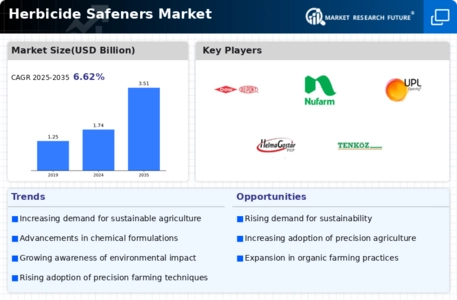Market Analysis
In-depth Analysis of Herbicide Safeners Market Industry Landscape
herbicide safeners market dynamics of the revolve around the need to protect crops from the harmful effects of herbicides while maximizing their weed-killing efficacy. Herbicide safeners are chemical compounds added to herbicide formulations to enhance the safety of crops, particularly cereals, corn, and rice, by promoting their tolerance to herbicide applications. These safeners play a crucial role in modern agriculture, where herbicides are extensively used to control weeds and optimize crop yields.
One of the primary drivers of the herbicide safeners market is the widespread adoption of herbicide-tolerant crops. Herbicide-tolerant crop varieties, genetically engineered to withstand herbicide applications, offer several benefits to farmers, including simplified weed management, increased flexibility in herbicide use, and improved crop yields. However, some herbicides can cause phytotoxicity or crop injury under certain conditions, particularly when applied at higher rates or under adverse environmental conditions. Herbicide safeners mitigate these risks by enhancing the crop's ability to metabolize and detoxify herbicides, thereby minimizing herbicide-induced crop damage and maximizing herbicide efficacy.
Changes in weed management practices and herbicide usage patterns also influence the dynamics of the herbicide safeners market. With the rise of herbicide-resistant weeds and concerns about herbicide residues in the environment and food chain, farmers are increasingly adopting integrated weed management strategies that incorporate multiple weed control tactics, including herbicide safeners. By incorporating herbicide safeners into their weed control programs, farmers can reduce reliance on high herbicide doses and minimize the risk of weed resistance while protecting crop yields.
Regulatory policies and environmental concerns play a significant role in shaping the dynamics of the herbicide safeners market. Governments and regulatory agencies impose regulations and guidelines to ensure the safety, efficacy, and environmental compatibility of herbicide and safener products. Compliance with regulatory requirements, such as registration, labeling, and environmental risk assessments, is essential for herbicide safener manufacturers to access markets and maintain regulatory compliance. Changes in regulatory frameworks or the introduction of new regulations can impact market dynamics by influencing product formulations, usage guidelines, and market access.
Technological advancements in herbicide safener research and development drive innovation in the herbicide safeners market. Research efforts focus on developing new safener compounds with improved efficacy, selectivity, and environmental safety profiles. This includes the use of advanced molecular biology techniques and high-throughput screening methods to identify safener candidates and optimize their performance characteristics. Additionally, collaborations between academia, industry, and government research institutions facilitate knowledge sharing and technology transfer, accelerating the pace of innovation in the industry.
Global trade patterns and market competition further contribute to herbicide safeners market dynamics. Herbicide safeners are traded globally, with production and consumption occurring across multiple regions. Shifts in trade flows, import/export regulations, and market access agreements can affect market dynamics by influencing supply chains, pricing, and availability of herbicide safener products. Additionally, the presence of multiple herbicide safener manufacturers and suppliers competing for market share drives innovation, price competition, and product differentiation within the industry.
In conclusion, the herbicide safeners market dynamics are shaped by a complex interplay of factors including herbicide-tolerant crop adoption, changes in weed management practices, regulatory policies, environmental concerns, technological advancements, global trade patterns, and market competition. Understanding these dynamics is essential for stakeholders within the herbicide safeners industry to anticipate trends, identify opportunities, and navigate challenges in this dynamic and essential sector of the global agriculture market.









Leave a Comment